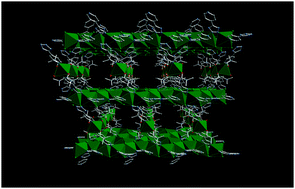Solid state coordination chemistry of microporous metal–organic frameworks of the cadmium(ii)–4-pyridyltetrazolate family: the structural influences of chloride incorporation†
Abstract
While the metal–organic framework [Cd4(OH)2(4-pt)6(DMF)4]·12DMF (1·12DMF) (4-pt = 4-pyridyltetrazolate) is constructed from binuclear metal subunits, linked into porous {Cd2(OH)(DMF)2(4-pt)3}6 cages, introduction of increasing concentrations of chloride yields the 3-D framework materials, [Cd4Cl3(4-pt)4(OH)(DMF)3]·8DMF·14MeOH (2·8DMF·14MeOH) and [Cd5Cl6(4-pt)(DMF)2(H2O)2]·10DMF (3·10DMF), constructed from tetranuclear and chain building blocks, respectively.


 Please wait while we load your content...
Please wait while we load your content...